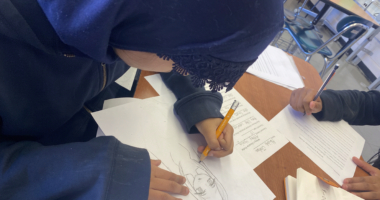In addition to assisting at an in-school residency for my TATIP internship, I am thrilled to be co-leading two after-school residencies with the CUNY Creative Arts Team (CAT). I have the unique opportunity to both observe teaching strategies and execute them myself.
The TATIP seminars on classroom management and my classroom internship experience have prepared me well for my new residencies. Two tactics discussed during TATIP training have proved especially helpful: 1) Using different strategies for different students. 2) Playing the waiting game.
There is a breadth of research supporting the benefits of individualized instruction and, not surprisingly, individualized classroom management methods. A notable classroom strategy study conducted by Jere Brophy in 1981, observed and interviewed 98 teachers and then classified them as either effective or ineffective instructors. Teachers were presented with vignettes regarding specific types of students in specific situations and had to respond to them accordingly. The study found that effective classroom managers used different types of strategies with different types of students. Ineffective managers resorted to the same strategies regardless of the student or particular situation.
Simply put, no single formula will solve every classroom management issue because every student and every situation is different. However, this did not click for me until I experienced it firsthand at my CAT residencies.
So far, the two main disruptive personalities I have experienced are the class clown and the easily distracted student. A valuable lesson I learned from Patti Chilsen and Renée Watson, our TATIP seminar facilitators, is that the class clown is disruptive to get attention from both his or her classmates and teacher. While the intuitive option might be to single them out for their negative behavior to squash the problem, doing so can actually validate them and does not necessarily shift their behavior. Patti and Renée suggest to place the focus on the students that are on task, saying something like “I really appreciate how quiet and respectful Tim and Lauren are being.” The students that are not on task see that you only acknowledge good behavior and will likely correct theirs so that they too will be acknowledged. This has worked wonders in my classes because ultimately, all students want to be praised so they choose praise-worthy behavior.
I have found that it is often best to call out the students that are simply unfocused. Unlike the class clown, these students are not purposefully distracting others, but they have trouble paying attention. In my after-school classes, I am particularly understanding of this; the kids come from a long day of school and need a mental break. Usually, the unfocused students don’t even realize they’re causing a problem and just need a gentle reminder to get back on task.
A second extremely effective classroom management strategy is playing the waiting game. Patti and Renée explained why the three most powerful words to get a class back on track can be “I will wait.” When a teacher says those words, a shift occurs; the agency is placed on the students and the ball is in their court. The students become solely responsible for moving the class forward.
If my students are too loud, I simply will not continue and will wait as long as it takes. Sometimes I’ll use sound cues such as a clapping pattern, but I will usually just silently pace across the room. Initially, I was worried that waiting for the students to quiet down by themselves would waste too much time. Then I realized that it was not a time-waster at all. In fact, some really informative and productive moments have happened during this waiting period. Ultimately, the kids want to participate and want to know my next instructions. Eventually, as students start noticing I am silent, they tell each other to stop talking. They end up doing all the work for me!
This mini ritual accomplishes a couple of things besides simply managing the class. It prompts teambuilding; as some kids express frustration at others for not allowing the class to progress, they must all work together to allow the class to continue. They also begin to understand that their behavior has a direct impact on their classmates’ experience. Just one person talking can hold up the whole class. Waiting silently also serves as a kind of check-in. If it takes longer than usual for them to get quiet, I might note that they are less focused or that something about the activity is not working. In those valuable seconds (and sometimes minutes) that I wait for them, I learn a lot about the group’s energy.
Despite how powerful these methods are in the classroom, I am reminded that the foundation of a well-balanced and cohesive classroom remains the same each day. Any student demographic responds to work that engages and interests them and lets them have fun. Kids want to be active and curious and if your curriculum inspires them to be so, they will be on board with you. And once they are on board, it’s pretty smooth sailing.
-Ally Tufenkjian, Theatre Artist, TATIP Trainee



